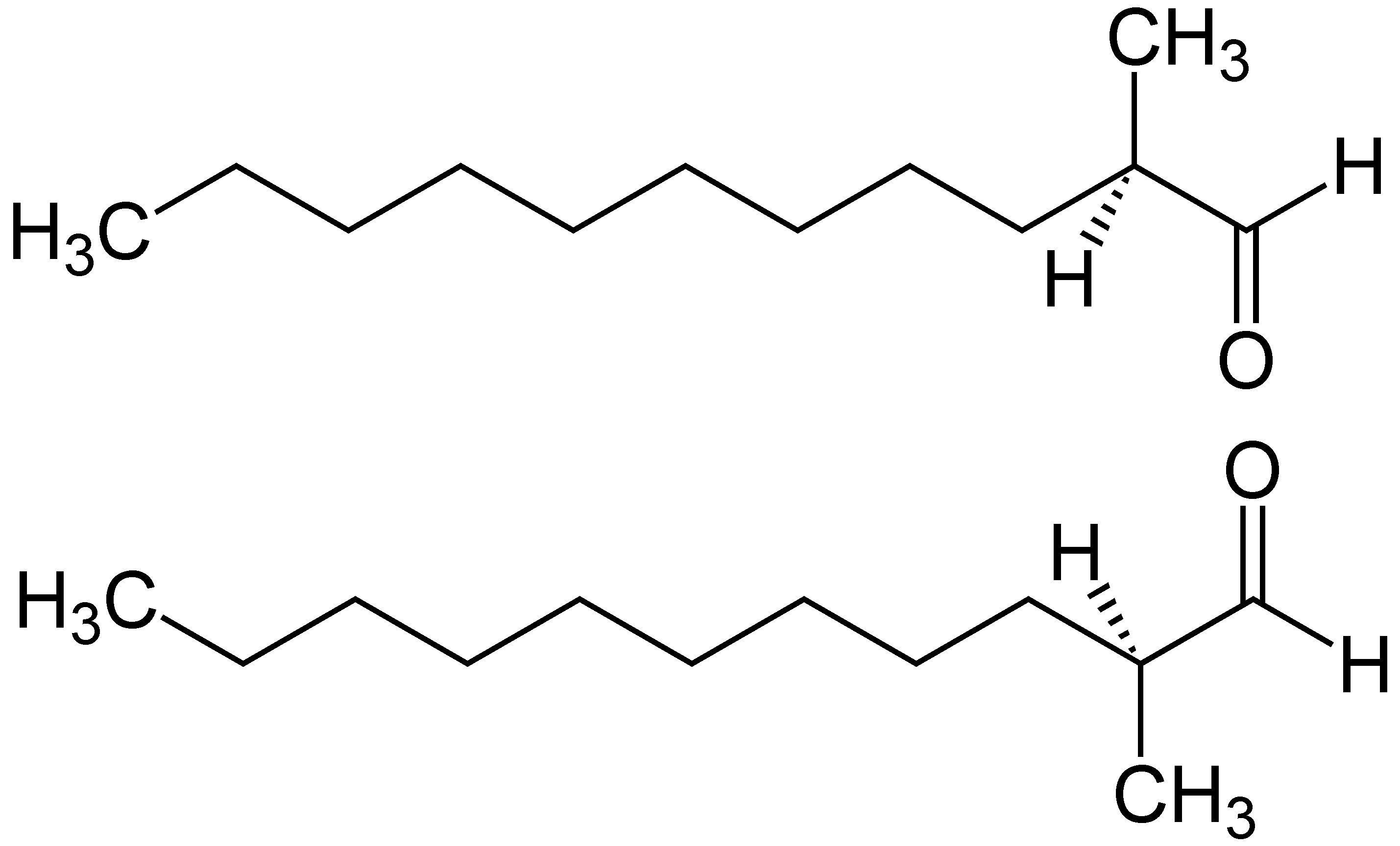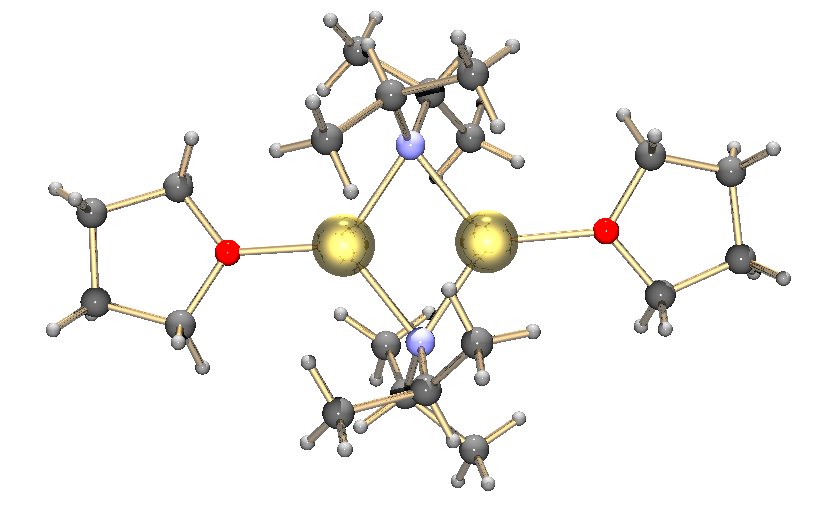|
2-Methylundecanal
2-Methylundecanal is an organic compound that is found naturally in kumquat peel oil. This compound smells herbaceous, orange, and ambergris-like. At high dilution it has a flavor similar to honey and nuts. It is a colorless or pale yellow liquid that is soluble in organic solvents such as ether and ethanol. It is used as a fragrance component in soaps, detergents, and perfumes. Preparation The first synthesis of 2-methylundecanal was recorded by Georges Darzens in 1904 from methyl nonyl ketone and ethyl chloroacetate. This method of synthesis can be used to produce a variety of aldehydes and became known as the Darzens reaction and is still used today. 2-Methylundecanal is synthesized in industry by two main routes. The first route, like Darzens, involves converting methyl nonyl ketone to its glycidate by allowing it to react with alkyl chloroacetate. The glycidate then undergoes saponification followed by decarboxylation. :CH3(CH2)8C(O)CH3 + ClCH2CO2CH3 → CH3(CH2)8CH(CH3 ... [...More Info...] [...Related Items...] OR: [Wikipedia] [Google] [Baidu] |
Hexyl Cinnamaldehyde
Hexyl cinnamaldehyde (hexyl cinnamal) is a common additive in the perfume and cosmetic industry as aroma substance. It is found naturally in the essential oil of chamomile. It is a pale yellow to yellow liquid to solid, which is nearly insoluble in water but soluble in oils. The commercial material often contains low levels of 2,6-di-tert-butyl-4-methoxyphenol as a stabilizer. One supplier reported that its hexyl cinnamaldehyde (or "hexyl cinnamic aldehyde") contained at least 90% ''trans'' isomer. Synthesis Hexyl cinnamaldehyde is typically produced via crossed- aldol condensation of octanal and benzaldehyde Benzaldehyde (C6H5CHO) is an organic compound consisting of a benzene ring with a formyl substituent. It is the simplest aromatic aldehyde and one of the most industrially useful. It is a colorless liquid with a characteristic almond-like odor. .... Safety Hexyl cinnamaldehyde is known to cause contact allergies in some individuals but the rate of incidence is low, w ... [...More Info...] [...Related Items...] OR: [Wikipedia] [Google] [Baidu] |
Kumquat
Kumquats (; zh, 金桔), or cumquats in Australian English, are a group of small fruit-bearing trees in the flowering plant family Rutaceae. Their taxonomy is disputed. They were previously classified as forming the now-historical genus ''Fortunella'' or placed within ''Citrus'', . Different classifications have alternatively assigned them to anywhere from a single species, ''C. japonica'', to numerous species representing each cultivar. Recent genomic analysis would define three pure species, ''Citrus hindsii'', ''C. margarita'' and ''C. crassifolia'', with ''C. x japonica'' being a hybrid of the last two. The edible fruit closely resembles the orange (''Citrus sinensis'') in color and shape but is much smaller, being approximately the size of a large olive. The kumquat is a fairly cold-hardy citrus. Etymology The English name "kumquat" is a borrowing of the Cantonese ''gāmgwāt'' (). Origin The kumquat plant is native to Southern China. The historical reference to kum ... [...More Info...] [...Related Items...] OR: [Wikipedia] [Google] [Baidu] |
Isobutyraldehyde
Isobutyraldehyde is the chemical compound with the formula (CH3)2CHCHO. It is an aldehyde, isomeric with n-butyraldehyde (butanal). Isobutyraldehyde is made, often as a side-product, by the hydroformylation of propene. Its odour is described as that of wet cereal or straw. It undergoes the Cannizaro reaction even though it has alpha hydrogen atom. It is a colorless volatile liquid. Synthesis Isobutyraldehyde is produced industrially by the hydroformylation of propene. Several million tons are produced annually.Boy Cornils, Richard W. Fischer, Christian Kohlpaintner "Butanals" in Ullmann's Encyclopedia of Industrial Chemistry, 2000, Wiley-VCH, Weinheim. Biological routes In the context of butanol fuel, isobutyraldehyde is of interest as a precursor to isobutanol. ''E. coli'' as well as several other organisms has been genetically modified to produce isobutanol. α-Ketoisovalerate, derived from oxidative deamination of valine, is prone to decarboxylation to give isobutyraldehyd ... [...More Info...] [...Related Items...] OR: [Wikipedia] [Google] [Baidu] |
Lilial
Lilial (a trade name for lily aldehyde, also known as lysmeral) is a chemical compound commonly used as a perfume in cosmetic preparations and laundry powders, often under the name ''butylphenyl methylpropional''. It is a synthetic aromatic aldehyde. It was banned for use in cosmetics by the EU in March 2022 after being found to be harmful to fertility. Synthesis Lilial is produced at BASF through a double anodic oxidation of 4-''tert''butyl-toluene on >10,000 ton per year scale. Properties Lilial is commonly produced and sold as a racemic mixture; however, testing has indicated that the different enantiomers of the compound do not contribute equally to its odor. The (''R'')-enantiomer has a strong floral odor, reminiscent of cyclamen or lily of the valley; whereas the (''S'')-enantiomer possesses no strong odor. : Like most aldehydes, lilial is not long term stable and tends to slowly oxidize on storage. Safety The Scientific Committee on Consumer Safety (SCCS, scientific com ... [...More Info...] [...Related Items...] OR: [Wikipedia] [Google] [Baidu] |
Dimethyl Sulfate
Dimethyl sulfate (DMS) is a chemical compound with formula (CH3O)2SO2. As the diester of methanol and sulfuric acid, its formula is often written as ( CH3)2 SO4 or Me2SO4, where CH3 or Me is methyl. Me2SO4 is mainly used as a methylating agent in organic synthesis. Me2SO4 is a colourless oily liquid with a slight onion-like odour (although smelling it would represent significant exposure). Like all strong alkylating agents, Me2SO4 is extremely toxic. Its use as a laboratory reagent has been superseded to some extent by methyl triflate, CF3SO3CH3, the methyl ester of trifluoromethanesulfonic acid. History Dimethyl sulfate was discovered in the early 19th century in an impure form. J. P. Claesson later extensively studied its preparation. It was investigated as a candidate for possible use chemical warfare in World War I in 75% to 25% mixture with methyl chlorosulfonate (CH3ClO3S) called "C-stoff" in Germany, or with chlorosulfonic acid called "Rationite" in France. Product ... [...More Info...] [...Related Items...] OR: [Wikipedia] [Google] [Baidu] |
Alkylation
Alkylation is the transfer of an alkyl group from one molecule to another. The alkyl group may be transferred as an alkyl carbocation, a free radical, a carbanion, or a carbene (or their equivalents). Alkylating agents are reagents for effecting alkylation. Alkyl groups can also be removed in a process known as dealkylation. Alkylating agents are often classified according to their nucleophilic or electrophilic character. In oil refining contexts, alkylation refers to a particular alkylation of isobutane with olefins. For upgrading of petroleum, alkylation produces a premium blending stock for gasoline. In medicine, alkylation of DNA is used in chemotherapy to damage the DNA of cancer cells. Alkylation is accomplished with the class of drugs called alkylating antineoplastic agents. Nucleophilic alkylating agents Nucleophilic alkylating agents deliver the equivalent of an alkyl anion ( carbanion). The formal "alkyl anion" attacks an electrophile, forming a new covalent ... [...More Info...] [...Related Items...] OR: [Wikipedia] [Google] [Baidu] |
Lithium Diisopropylamide
Lithium diisopropylamide (commonly abbreviated LDA) is a chemical compound with the molecular formula . It is used as a strong base and has been widely utilized due to its good solubility in non-polar organic solvents and non-nucleophilic nature. It is a colorless solid, but is usually generated and observed only in solution. It was first prepared by Hamell and Levine in 1950 along with several other hindered lithium diorganylamides to effect the deprotonation of esters at the α position without attack of the carbonyl group. Preparation and structure LDA is commonly formed by treating a cooled (0 to −78 °C) mixture of tetrahydrofuran and diisopropylamine with ''n''-butyllithium. When dissociated, the diisopropylamide anion can become protonated to form diisopropylamine. Diisopropylamine has a p''K''a value of 36. Therefore, its conjugate base is suitable for the deprotonation of compounds with greater acidity, importantly, such weakly acidic compounds (carbon acids) ... [...More Info...] [...Related Items...] OR: [Wikipedia] [Google] [Baidu] |
Metalation
Metalation (Alt. spelling: Metallation) is a chemical reaction that forms a bond to a metal. This reaction usually refers to the replacement of a halogen atom in an organic molecule with a metal atom, resulting in an organometallic compound. In the laboratory, metalation is commonly used to activate organic molecules during the formation of C—X bonds (where X is typically carbon, oxygen, or nitrogen), which are necessary for the synthesis of many organic molecules. In synthesis, metallated reagents are typically involved in nucleophilic substitution, single-electron-transfer (SET), and redox chemistry with functional groups on other molecules (including but not limited to ketones, aldehydes and alkyl halides). Metallated molecules may also participate in acid-base chemistry, with one organometallic reagent deprotonating an organic molecule to create a new organometallic reagent. The most common classes of metallated compounds are organolithium reagents and Grignard reagents. Ho ... [...More Info...] [...Related Items...] OR: [Wikipedia] [Google] [Baidu] |
Base (chemistry)
In chemistry, there are three definitions in common use of the word base, known as Arrhenius bases, Brønsted bases, and Lewis bases. All definitions agree that bases are substances that react with acids, as originally proposed by G.-F. Rouelle in the mid-18th century. In 1884, Svante Arrhenius proposed that a base is a substance which dissociates in aqueous solution to form Hydroxide ions OH−. These ions can react with hydrogen ions (H+ according to Arrhenius) from the dissociation of acids to form water in an acid–base reaction An acid–base reaction is a chemical reaction that occurs between an acid and a base. It can be used to determine pH via titration. Several theoretical frameworks provide alternative conceptions of the reaction mechanisms and their applica .... A base was therefore a metal hydroxide such as Sodium hydroxide, NaOH or Calcium hydroxide, Ca(OH)2. Such aqueous hydroxide solutions were also described by certain characteristic properties. ... [...More Info...] [...Related Items...] OR: [Wikipedia] [Google] [Baidu] |
Enantiomer
In chemistry, an enantiomer ( /ɪˈnænti.əmər, ɛ-, -oʊ-/ ''ih-NAN-tee-ə-mər''; from Ancient Greek ἐνάντιος ''(enántios)'' 'opposite', and μέρος ''(méros)'' 'part') – also called optical isomer, antipode, or optical antipode – is one of two stereoisomers that are non-superposable onto their own mirror image. Enantiomers are much like one's right and left hands, when looking at the same face, they cannot be superposed onto each other. No amount of reorientation will allow the four unique groups on the chiral carbon (see Chirality (chemistry)) to line up exactly. The number of stereoisomers a molecule has can be determined by the number of chiral carbons it has. Stereoisomers include both enantiomers and diastereomers. Diastereomers, like enantiomers, share the same molecular formula and are non-superposable onto each other however, they are not mirror images of each other. A molecule with chirality rotates plane-polarized light. A mixture of equals a ... [...More Info...] [...Related Items...] OR: [Wikipedia] [Google] [Baidu] |
Asymmetric Carbon
An asymmetric carbon atom (chiral carbon) is a carbon atom that is attached to four different types of atoms or groups of atoms. Le Bel-van't Hoff rule states that the number of stereoisomers of an organic compound is 2n, where n represents the number of asymmetric carbon atoms (unless there is an internal plane of symmetry); a corollary of Le Bel and van't Hoff's simultaneously announced conclusions, in 1874, that the most probable orientation of the bonds of a carbon atom linked to four groups or atoms is toward the apexes of a tetrahedron, and that this accounted for all then-known phenomena of molecular asymmetry (which involved a carbon atom bearing four different atoms or groups). Knowing the number of asymmetric carbon atoms, one can calculate the maximum possible number of stereoisomers for any given molecule as follows: : If n is the number of asymmetric carbon atoms then the maximum number of isomers = 2n ( Le Bel-van't Hoff rule) As an example, malic acid has 4 carb ... [...More Info...] [...Related Items...] OR: [Wikipedia] [Google] [Baidu] |



